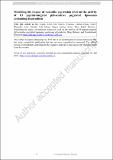Modelling the impact of nucleolin expression level on the activity of F3 peptide-targeted pH-sensitive pegylated liposomes containing doxorubicin
Author(s)
Lopes, Rui; Shi, Kevin; Fonseca, Nuno A.; Gama, Adelina; Ramalho, José S.; Almeida, Luís; Moura, Vera; Simões, Sérgio; Tidor, Bruce; Moreira, João N.; ... Show more Show less
Download13346_2021_972_ReferencePDF.pdf (3.891Mb)
Open Access Policy
Open Access Policy
Creative Commons Attribution-Noncommercial-Share Alike
Terms of use
Metadata
Show full item recordAbstract
Abstract
Strategies targeting nucleolin have enabled a significant improvement in intracellular bioavailability of their encapsulated payloads. In this respect, assessment of the impact of target cell heterogeneity and nucleolin homology across species (structurally and functionally) is of major importance. This work also aimed at mathematically modelling the nucleolin expression levels at the cell membrane, binding and internalization of pH-sensitive pegylated liposomes encapsulating doxorubicin and functionalized with the nucleolin-binding F3 peptide (PEGASEMP), and resulting cytotoxicity against cancer cells from mouse, rat, canine, and human origin. Herein, it was shown that nucleolin expression levels were not a limitation on the continuous internalization of F3 peptide-targeted liposomes, despite the saturable nature of the binding mechanism. Modeling enabled the prediction of nucleolin-mediated total doxorubicin exposure provided by the experimental settings of the assessment of PEGASEMP’s impact on cell death. The former increased proportionally with nucleolin-binding sites, a measure relevant for patient stratification. This pattern of variation was observed for the resulting cell death in nonsaturating conditions, depending on the cancer cell sensitivity to doxorubicin. This approach differs from standard determination of cytotoxic concentrations, which normally report values of incubation doses rather than the actual intracellular bioactive drug exposure. Importantly, in the context of development of nucleolin-based targeted drug delivery, the structural nucleolin homology (higher than 84%) and functional similarity across species presented herein, emphasized the potential to use toxicological data and other metrics from lower species to infer the dose for a first-in-human trial.
Graphical abstract
Date issued
2021-04-15Department
Massachusetts Institute of Technology. Department of Biological Engineering; Massachusetts Institute of Technology. Department of Electrical Engineering and Computer SciencePublisher
Springer US
Citation
Lopes, Rui, Shi, Kevin, Fonseca, Nuno A., Gama, Adelina, Ramalho, José S. et al. 2021. "Modelling the impact of nucleolin expression level on the activity of F3 peptide-targeted pH-sensitive pegylated liposomes containing doxorubicin."
Version: Author's final manuscript